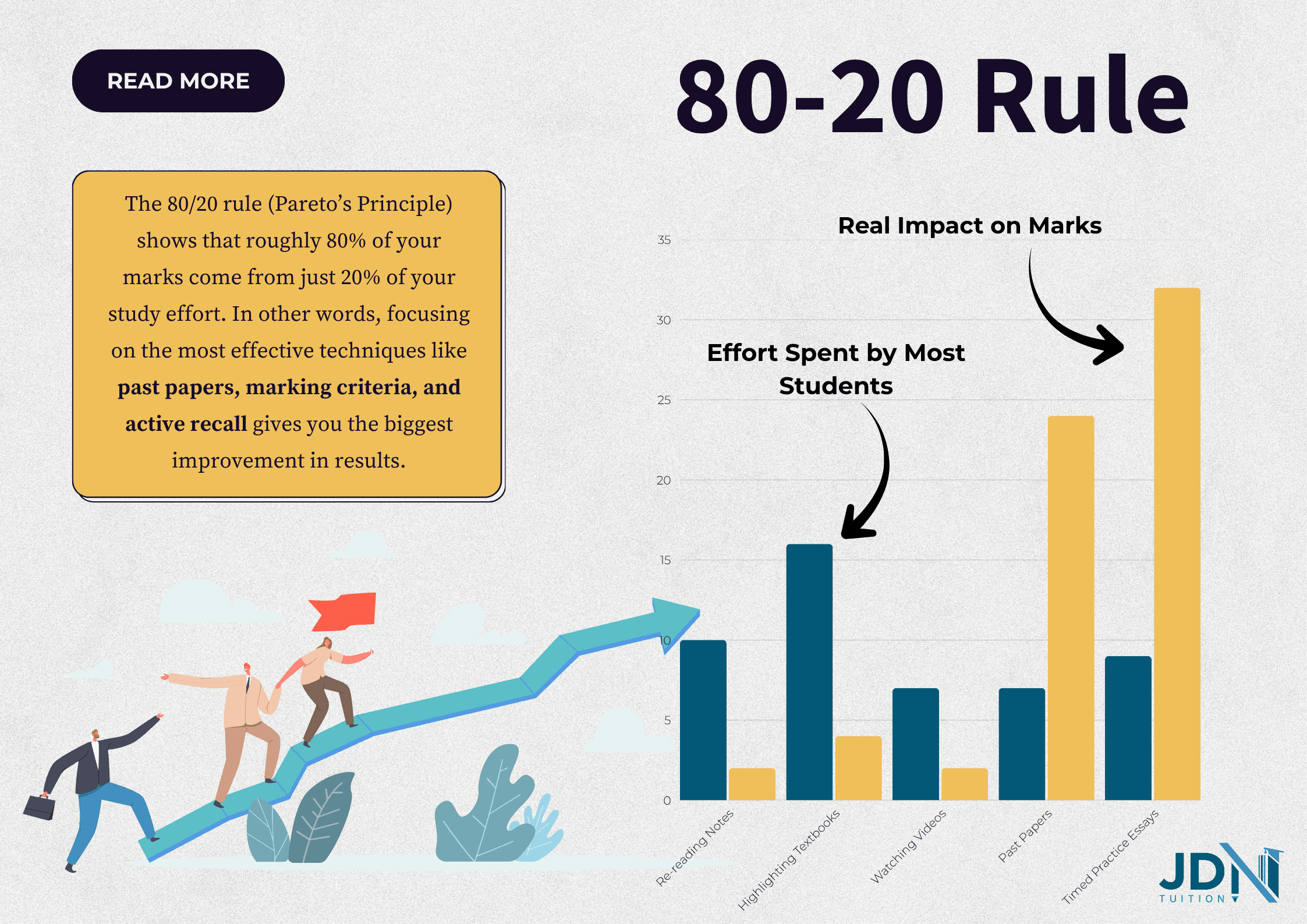
Most HSC students spend their nights exhausted, highlighting textbooks and cramming last-minute for an upcoming exam. If you’re a NSW high school student slogging through stacks of notes, late nights highlighting textbooks, or sleeping late going over every single topic “just in case,” you might be working harder, but perhaps not smarter. The 80/20 rule for the HSC (a.k.a. Pareto’s Principle) flips that idea on its head: roughly 20% of your study efforts lead to more than 80% of your marks. What if instead of spreading yourself thin, you invested your time in the high-impact areas that can truly change your HSC results?
In this JDN Tuition blog, you’ll discover how to use the 80/20 rule in studying, and how to identify which topics, skills, and past paper behaviours deliver the biggest return on investment. We’ll explore subject-specific examples from HSC English essay structure and writing strong textual evidence, to mastering year 12 mathematics learning outcomes, key year 11 content, and legal case studies, so that you can spend less time on busy work and more time doing what counts. By applying the 80/20 technique, you can reduce exam stress, sharpen your focus, and boost your higher school certificate marks.
The 80/20 Rule, also known as Pareto’s Principle, is the simple but powerful idea that 80% of your learning outcomes come from just 20% of your efforts. In other words, not everything you do matters equally, and finding what does is the key to success. When applied to year 12 exams like the HSC, this means a small number of study strategies, like working through HSC past papers, reviewing HSC exam paper marking guidelines, and active learning, can deliver an optimal ATAR.
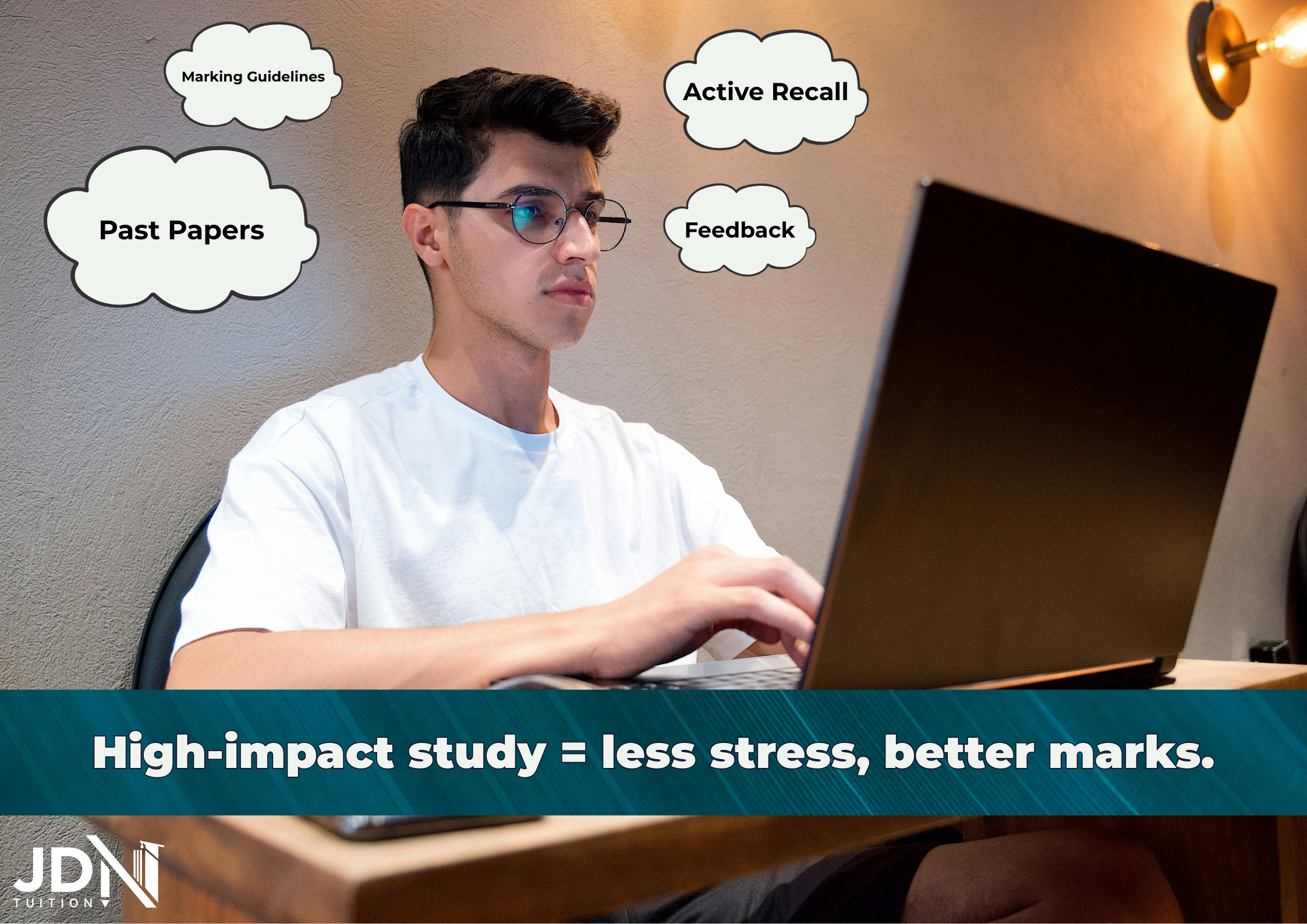
Instead of cramming every detail or rewriting notes for hours, smart students prioritise study tasks that truly influence exam results. In HSC English, for instance, 20% of your skills — such as thesis clarity, strong structure, and effective use of evidence — can produce 80% of your essay marks. Spending days memorising notes, on the other hand, wastes time and often leads to poor time management. Properly identifying the most efficient focuses for study will help you study less and achieve more by perfectly matching your HSC exam timetable for the best results.
For NSW high school students, understanding the 80/20 principle helps you work smarter, not harder. It saves time in your study routine and moves you closer to Band 6 results. By shifting focus away from low-value, time-wasting tasks and towards high-impact HSC study techniques, you can boost your marks and reduce stress at the same time.
One of the biggest challenges for HSC students is that their daily habits don’t always align with what actually gets top marks in the HSC. Many students feel productive when they spend hours note taking, rewriting presentations, highlighting every line of a textbook, or colour-coding folders. While these routines may look neat, they often fall into the “low-impact” category of study: activities that consume time but do little to improve real exam performance.
The truth is, HSC markers don’t reward beautifully decorated notes or perfectly summarised textbooks. When they assess your biology paper, they’re looking for proof that you understand the course content and can apply critical thinking techniques. That means expressing your knowledge through structured responses and clear use of syllabus verbs such as evaluate, assess, and explain.
Spending too much time on cosmetic tasks creates a false sense of progress without improving your marks. This is why the 80/20 rule is so powerful. It teaches you to prioritise what matters and replace ineffective study habits with smarter routines that prepare you for real exam conditions.
Often, the difference between students who score in the mid-band and those who achieve a 95+ ATAR with JDN Tuition’s Year 11 and 12 tutoring lies in structure. Our expert tutors help you design efficient study blocks and prioritise the activities that deliver the biggest results.
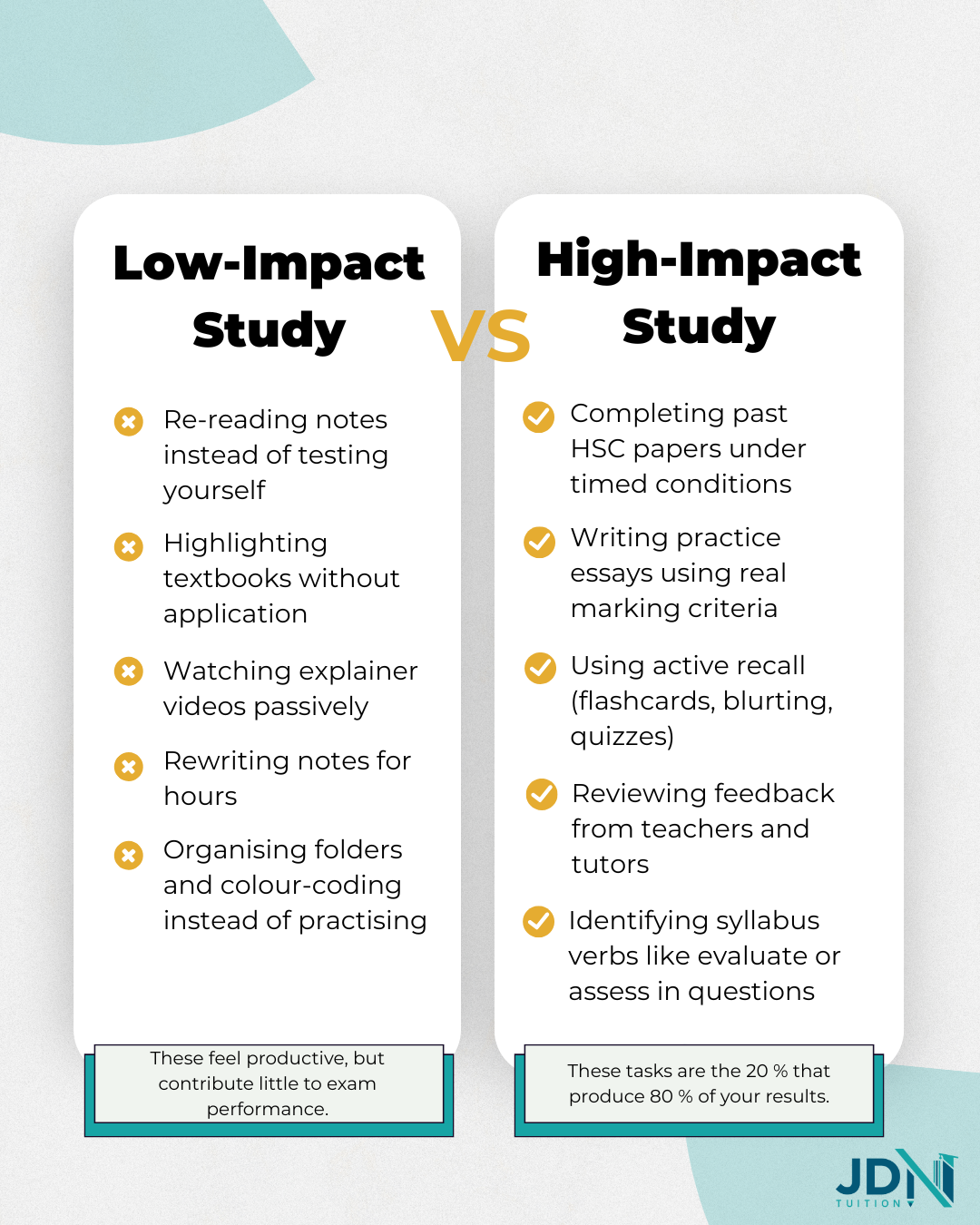
If your child is spending hours on low-impact study, JDN Tuition can help them get ahead of their class this school term. With top-level tutors trained in maximizing the 80/20 rule, contact us today and find out why Australia’s parents choose us for their HSC tutoring needs.
To make the 80/20 rule work for HSC studies, students need to know which parts of their HSC subjects list tend to deliver the biggest mark payoff. Below are how NSW HSC students can apply it to key subject areas like English, Mathematics, Science, and the Humanities.
Knowing how to use the 80/20 rule in studying is only the first step. The challenging part is figuring out which parts of your studies are the 20% that yield 80% of the marks. Below are some evidence-based methods and resources students can use to identify high-impact areas precisely.
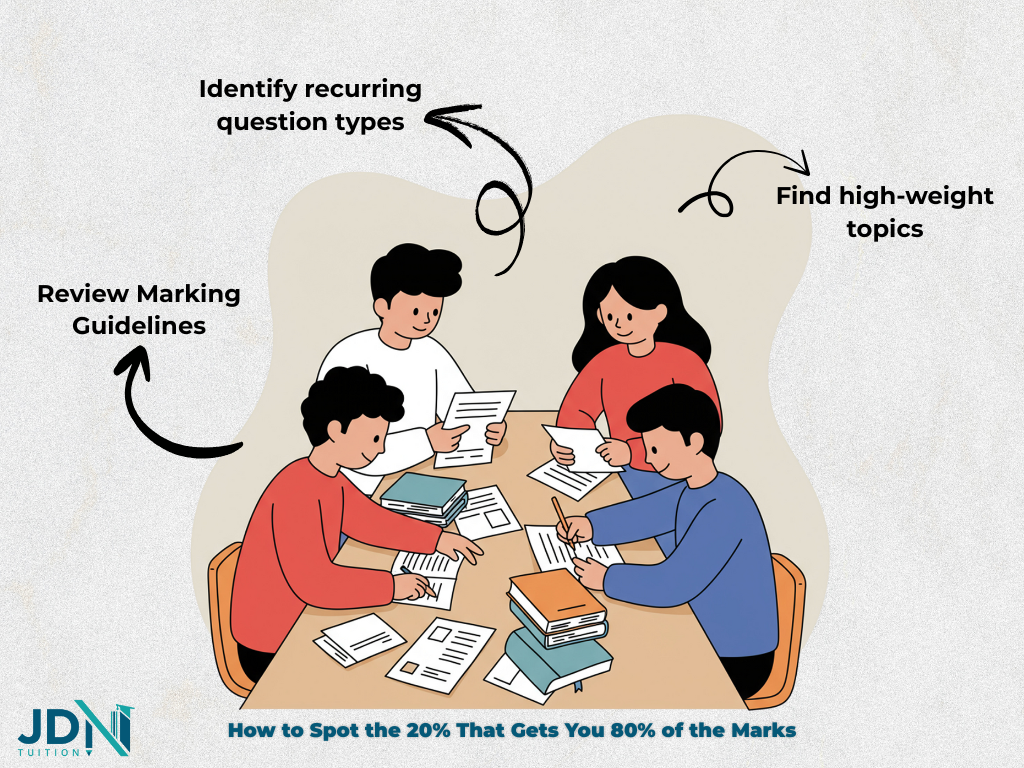
Your strongest tool for identifying the 80/20 rule for learning is actual past paper exams, especially when used with the official marking guidelines and feedback from NESA. Understanding how to use HSC past papers effectively gives you insight into what’s actually required of you in the exam.
Feedback is useless if you collect but don’t act on it. To identify what gives marks, you must listen to feedback, analyse it, and adjust your study accordingly.
When you apply the 80/20 rule to study, you stop trying to do everything and focus on what truly matters. This simple shift improves stress management by shrinking your to-do list. It also reduces decision fatigue and gives you a stronger sense of control. It also nudges you towards a growth mindset: you spend your best energy on getting feedback, practising high-value exam skills, and improving based on prior mistakes, rather than ruminating over busywork.
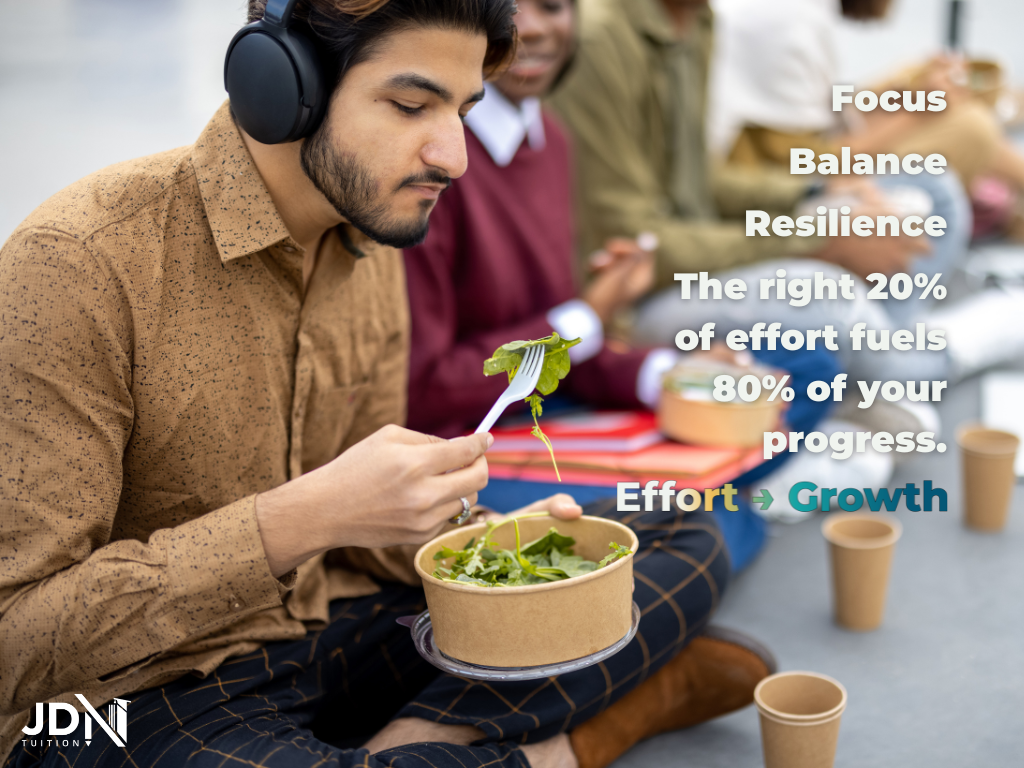
The 80/20 rule also frees up time for routines that protect your energy and focus. One powerful example is building a healthy meal routine that’s simple, uses the 80/20 rule, and follows the Australian dietary guidelines. This creates a sustainable foundation that supports the intense study blocks the Pareto principle demands.
Just as importantly, the 80/20 rule’s growth mindset helps you be selective about how you recharge. Instead of filling your afternoons with low-value breaks, choose extracurricular activities that genuinely restore you. Pick options that build transferable skills such as teamwork, discipline, and creativity.
In the case of after-school activities, quality counts more than quantity. One or two purposeful commitments — such as sport, music, debating, or volunteering — can build resilience and confidence that carry over into exams. When students combine a positive mindset with the 80/20 rule, they learn to manage stress effectively. This approach also frees up time to further develop their strengths.
A common pitfall is using the 80/20 rule as an excuse to cut corners. Some students skip core syllabus outcomes or ignore weak topics because they feel uncomfortable. While it may seem easier, this approach defeats the purpose of the technique. It pulls you away from the 20% that delivers the greatest results. In a similar vein, confusing busy work with high-impact tasks is just not helpful. Endless note-rewrites and passive reading won’t move the needle like timed past papers aligned to marking guidelines and active learning. Additionally, don’t chase the novelty; switching between the newest and best studying hacks every week actually dilutes focus. Instead, stick to a small set of proven routines and track your results for optimal gains. Finally, don’t ignore feedback loops. The 80/20 rule only works when you review your errors, adjust your plan, and focus on what truly improves your marks under HSC conditions.
Once you know what to focus on for maximum marks using the 80/20 rule, the next step is execution. This is where HSC tutoring makes a difference. It acts as a springboard, sharpening those key 20% high-impact tasks. Tutoring also tailors your study to your unique strengths and weaknesses, ensuring your time is spent where it truly counts.
Private or one-on-one tutoring provides the kind of targeted support that classrooms rarely can. Private tutoring is crucial for Year 11 and 12 students who need guidance tailored to the HSC’s specific demands. Experienced tutors familiar with the NSW curriculum bring insider knowledge of what markers truly reward — helping students reach the next level with confidence.
Tutoring also adds structure to the foundational parts of Pareto’s Principle that are often overlooked. JDN Tuition offers both In-Home and Online Tutoring Services for HSC students. Our tutors can help you practise timed past papers, dissect marking guidelines, and ensure your study covers syllabus outcomes that are actually assessed.
This kind of support reduces time wasted on low-impact revision. With a tutor’s help, you can apply the 80/20 rule effectively and create a long-term study plan. Don’t waste another week on a low-impact study — book now with JDN Tuition today and start focusing on the 20% that delivers 80% of your success.
Another major benefit is feedback. Online tutors simulate exam conditions, and mark your responses with the same criteria as NESA, then walk you through what you’ve done well and what might need a touch of improvement. One-on-one tutoring enables more immediate correction of misconceptions, errors, and misinterpretations of the marking rubric than what might happen in a large classroom setting, giving students the attention they need to rise above their peers.
Check out our reviews to see why Australia’s parents choose JDN Tuition as one of their most trusted HSC tutoring providers. JDN Tuition can help your child use the 80/20 rule today and ensure they have the confidence they need to succeed. To help your child excel, contact us right now and make the best out of their academic journey.
Although the 80 to 20 ratio is suggested, it may not always work best for some HSC subjects. For example, subjects that rely heavily on foundational knowledge, such as Mathematics Extension, might follow a 70/30 ratio. In these cases, more content needs to be covered to see the greatest effect. The 80/20 rule still holds in principle. Its key lesson is to focus on high-impact tasks — that approach will take you furthest, no matter the exact ratio.
The easiest way to find the 20% in the 80/20 rule is to audit your last 3–5 papers. Note which topics appear often, which questions have the highest mark values, and where students commonly lose marks. Then, cross-check the marking guidelines to see what top-band answers consistently include — such as a clear thesis and strong structure. This process helps you identify exactly what to focus on.
Yes — if you apply it properly. Many top students use Pareto’s Principle to reach the highest bands. That doesn’t mean they can afford to slack off. Focus on high-impact tasks such as timed past papers, marking-criteria alignment, and targeted error correction. Create tight feedback loops — teacher, tutor, or self-assessment → fixes → reattempt — for the best results. Over a term, these compound gains can lift you into Band 6 territory.